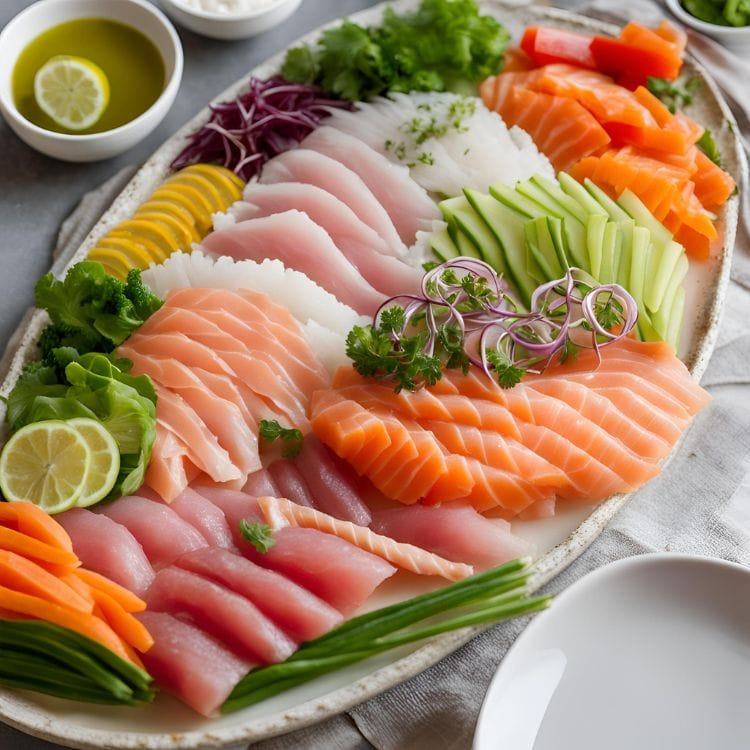Creating a sashimi platter is an art form rooted in Japanese culinary tradition, celebrated globally for its simplicity, elegance, and focus on fresh ingredients. In this guide, our expert chefs from Fronteras KC will walk you through each step of the process to create a visually stunning and delicious sashimi platter. With the right technique and a few essential ingredients, you’ll learn how to make sashimi at home that rivals the finest restaurant offerings.
A sashimi platter showcases the freshness and quality of raw fish, often accompanied by garnishes and sauces that enhance its delicate flavors. Originating from Japan, sashimi has become popular worldwide, appreciated by those who enjoy raw, high-quality seafood. Preparing sashimi at home allows you to experiment with different types of fish, vegetables, and presentation styles. Let’s dive in and create a platter that’s as visually stunning as it is flavorful!
1. Ingredients
Creating the perfect sashimi platter requires a few key ingredients, each chosen for freshness and quality.
Essential Ingredients:
- Fresh Fish: High-quality cuts of tuna, salmon, yellowtail, or mackerel. Ensure the fish is labeled “sashimi-grade” or “sushi-grade.”
- Garnishes: Cucumber, daikon radish, and shiso leaves for traditional Japanese garnishes.
- Condiments: Soy sauce, wasabi, and pickled ginger.
- Lemon Wedges: Adds freshness and brightness to the platter.
Optional Ingredients:
- Sea Urchin (Uni): Adds a creamy, unique flavor.
- Octopus: Thinly sliced, blanched octopus can add texture to the platter.
- Edible Flowers: Enhances the presentation for an elegant, restaurant-quality look.
Substitutes:
- White Fish Options: Substitute yellowtail with snapper or halibut if unavailable.
- Vegetables: Thinly sliced bell peppers, carrots, or avocados for extra color.
2. Step-by-Step Instructions
Creating a sashimi platter at home involves preparation, cutting techniques, and careful plating. Follow these steps to achieve the best results:

Step 1: Source Fresh Fish
Visit a trusted fishmonger or specialty market that offers sashimi-grade fish. Purchase your fish on the day you plan to prepare the platter, ensuring it’s as fresh as possible.
Step 2: Prepare the Cutting Area
Sanitize your cutting board, and ensure your knife is extremely sharp. A dull blade can ruin the texture of the fish.
Step 3: Slice the Fish
- Salmon and Tuna: Cut into 1/4-inch slices against the grain for optimal texture.
- Yellowtail and White Fish: Cut at a slight angle to enhance flavor and appearance.
- Sea Urchin and Octopus: Slice thinly if using; sea urchin can also be spooned directly onto the platter.
Step 4: Arrange on the Platter
- Layer the Fish: Arrange fish slices in a fan shape for each type of fish.
- Add Garnishes: Place shiso leaves, cucumber slices, and radish in between fish sections to separate different types and add visual appeal.
- Include Condiments: Place soy sauce, wasabi, and pickled ginger in small bowls beside or on the platter.
Step 5: Finish with Final Touches
Add lemon wedges, edible flowers, or extra shiso leaves for a touch of color and presentation.
3. Tips and Tricks
Here are some pro tips from our chefs at Fronteras KC to elevate your sashimi platter:
- Choose Fresh, Sashimi-Grade Fish: Freshness is key to great sashimi. If sashimi-grade fish is unavailable, ask your fishmonger for advice.
- Cut Against the Grain: Slicing against the grain helps to retain texture and flavor.
- Use Ice to Keep Fish Cool: If preparing ahead, keep the platter on a bed of ice to maintain freshness.
- Avoid Overhandling: Keep direct contact to a minimum to avoid warming or altering the fish’s texture.
- Experiment with Toppings: Adding a touch of sesame seeds, a drizzle of ponzu sauce, or a sprinkle of sea salt can enhance flavor.
4. Nutritional Information
While sashimi is high in protein and omega-3 fatty acids, it’s also relatively low in calories and carbs, making it a great option for a light meal. Nutritional values will vary depending on the fish types and condiments used, but here’s a general estimate:
- Calories: 200-300 per serving (depending on fish type)
- Protein: 20-25 grams
- Fats: 10-15 grams
- Carbohydrates: 5 grams or less
Note: For exact nutritional values, refer to the specific fish and ingredients used.
5. FAQ
Q: Can I substitute salmon with another type of fish?
A: Yes, sashimi-grade tuna or yellowtail are excellent substitutes if salmon is unavailable.
Q: How long does it take to prepare a sashimi platter?
A: With pre-prepared fish, a sashimi platter can be ready in 15–30 minutes.
Q: What’s the best way to store leftovers?
A: Leftover sashimi should be stored in an airtight container in the refrigerator and consumed within 24 hours.
Q: How can I make the sashimi platter more colorful?
A: Add vegetables like bell peppers, edible flowers, or shiso leaves for additional color and garnish.
6. Pairing Suggestions and Conclusion
A sashimi platter pairs beautifully with sake, green tea, or light, crisp white wines. Additionally, sides like miso soup, steamed edamame, or a simple cucumber salad can complement the dish.
Preparing sashimi at home may seem daunting, but with a few basic ingredients and attention to detail, you can create a fresh, visually impressive sashimi platter. Enjoy experimenting with different fish types, garnishes, and presentation styles, and embrace the creative process of crafting your own sashimi platter.
Happy slicing and enjoy your sashimi experience, courtesy of the chefs at Fronteras KC!

Related Articles :